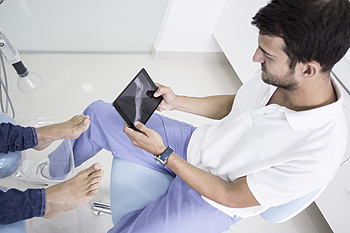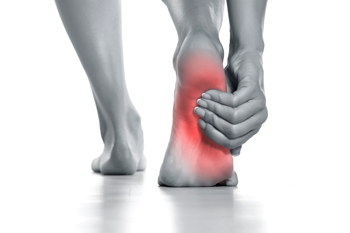Connect With Us
Blog

A podiatrist’s job focuses on diagnosing, treating, and preventing conditions that affect the feet and ankles. Their work ranges from caring for simple concerns like nail problems, calluses, or heel pain, to managing more complex issues such as fractures, tendon injuries, and chronic conditions that affect mobility. They examine how your feet function, evaluate symptoms, and use diagnostic tools like X-rays or ultrasounds to understand the source of discomfort. Podiatrists also play an important role in long-term health. They provide custom orthotics for support, monitor diabetic foot concerns, treat wounds, and guide patients through recovery after surgery or injury. Education is a major part of their work, helping people make better choices about footwear, activity levels, and overall foot health. When foot or ankle pain interferes with daily life or keeps returning, it is suggested that you see a podiatrist for a proper evaluation and appropriate treatment.
If you are experiencing pain in the feet or ankles, don’t join the stubborn majority refusing treatment. Feel free to contact one of our podiatrists from Foot & Ankle Medical Center . Our practitioners can provide the care you need to keep you pain-free and on your feet.
What Is a Podiatrist?
Someone would seek the care of a podiatrist if they have suffered a foot injury or have common foot ailments such as heal spurs, bunions, arch problems, deformities, ingrown toenails, corns, foot and ankle problems, etc.
Podiatric Treatment
A podiatrist will treat the problematic areas of the feet, ankle or lower leg by prescribing the following:
- Physical therapy
- Drugs
- Orthotic inserts or soles
- Surgery on lower extremity fractures
A common podiatric procedure a podiatrist will use is a scanner or force plate which will allow the podiatrist to know the designs of orthotics. Patients are then told to follow a series of tasks to complete the treatment. The computer will scan the foot a see which areas show weight distribution and pressure points. The podiatrist will read the analysis and then determine which treatment plans are available.
If you have any questions, please feel free to contact our offices located in Nampa and Fruitland, ID . We offer the newest diagnostic and treatment technologies for all your foot care needs.

Foot pain can arise from several conditions that affect the bones, tendons, or ligaments of the feet. Plantar fasciitis occurs when the tissue connecting the heel to the toes becomes inflamed, leading to sharp pain near the heel. Heel spurs, formed by calcium deposits on the heel bone, can irritate surrounding tissue and intensify discomfort. Bunions develop when the big toe joint shifts out of place, creating a painful bump that worsens with narrow or high-heeled shoes. Morton’s neuroma, caused by compression of a nerve between the toes, produces burning or tingling sensations in the forefoot. Stress fractures are small cracks in the metatarsal bones that result from repetitive strain, while sesamoiditis causes pain beneath the big toe due to overuse. A podiatrist can identify the specific cause of foot pain and provide proper treatment. If you are experiencing foot pain, it is suggested that you make an appointment with a podiatrist for a diagnosis and guidance on returning to activities.
Foot Pain
Foot pain can be extremely painful and debilitating. If you have a foot pain, consult with one of our podiatrists from Foot & Ankle Medical Center . Our practitioners will assess your condition and provide you with quality foot and ankle treatment.
Causes
Foot pain is a very broad condition that could be caused by one or more ailments. The most common include:
- Bunions
- Hammertoes
- Plantar Fasciitis
- Bone Spurs
- Corns
- Tarsal Tunnel Syndrome
- Ingrown Toenails
- Arthritis (such as Gout, Rheumatoid, and Osteoarthritis)
- Flat Feet
- Injury (from stress fractures, broken toe, foot, ankle, Achilles tendon ruptures, and sprains)
- And more
Diagnosis
To figure out the cause of foot pain, podiatrists utilize several different methods. This can range from simple visual inspections and sensation tests to X-rays and MRI scans. Prior medical history, family medical history, and any recent physical traumatic events will all be taken into consideration for a proper diagnosis.
Treatment
Treatment depends upon the cause of the foot pain. Whether it is resting, staying off the foot, or having surgery; podiatrists have a number of treatment options available for foot pain.
If you have any questions, please feel free to contact our offices located in Nampa and Fruitland, ID . We offer the newest diagnostic and treatment technologies for all your foot care needs.

Pronation is the natural inward rolling motion of the foot during walking or running, which allows the arch to absorb shock and distribute body weight efficiently. There are three main types of pronation that influence how pressure moves through the foot. Neutral pronation is when the foot rolls inward slightly, helping to maintain balance and reducing stress on the ankles and knees. Overpronation happens when the foot rolls inward excessively, often in people with low arches or flat feet, which can lead to heel, arch, or ankle pain. Underpronation, or supination, occurs when the foot rolls outward, placing stress on the outer edge of the foot and increasing the risk of ankle sprains or heel pain. A podiatrist can evaluate your gait, foot posture, and arch type to determine your pronation pattern and recommend corrective devices, supportive footwear, or, in severe cases, surgery. If you experience foot pain or gait problems, it is suggested that you make an appointment with a podiatrist for a diagnosis and treatment options.
If you have any concerns about your feet, contact one of our podiatrists from Foot & Ankle Medical Center . Our practitioners can provide the care you need to keep you pain-free and on your feet.
Biomechanics in Podiatry
Podiatric biomechanics is a particular sector of specialty podiatry with licensed practitioners who are trained to diagnose and treat conditions affecting the foot, ankle and lower leg. Biomechanics deals with the forces that act against the body, causing an interference with the biological structures. It focuses on the movement of the ankle, the foot and the forces that interact with them.
A History of Biomechanics
- Biomechanics dates back to the BC era in Egypt where evidence of professional foot care has been recorded.
- In 1974, biomechanics gained a higher profile from the studies of Merton Root, who claimed that by changing or controlling the forces between the ankle and the foot, corrections or conditions could be implemented to gain strength and coordination in the area.
Modern technological improvements are based on past theories and therapeutic processes that provide a better understanding of podiatric concepts for biomechanics. Computers can provide accurate information about the forces and patterns of the feet and lower legs.
Understanding biomechanics of the feet can help improve and eliminate pain, stopping further stress to the foot.
If you have any questions please feel free to contact our offices located in Nampa and Fruitland, ID . We offer the newest diagnostic and treatment technologies for all your foot and ankle needs.

